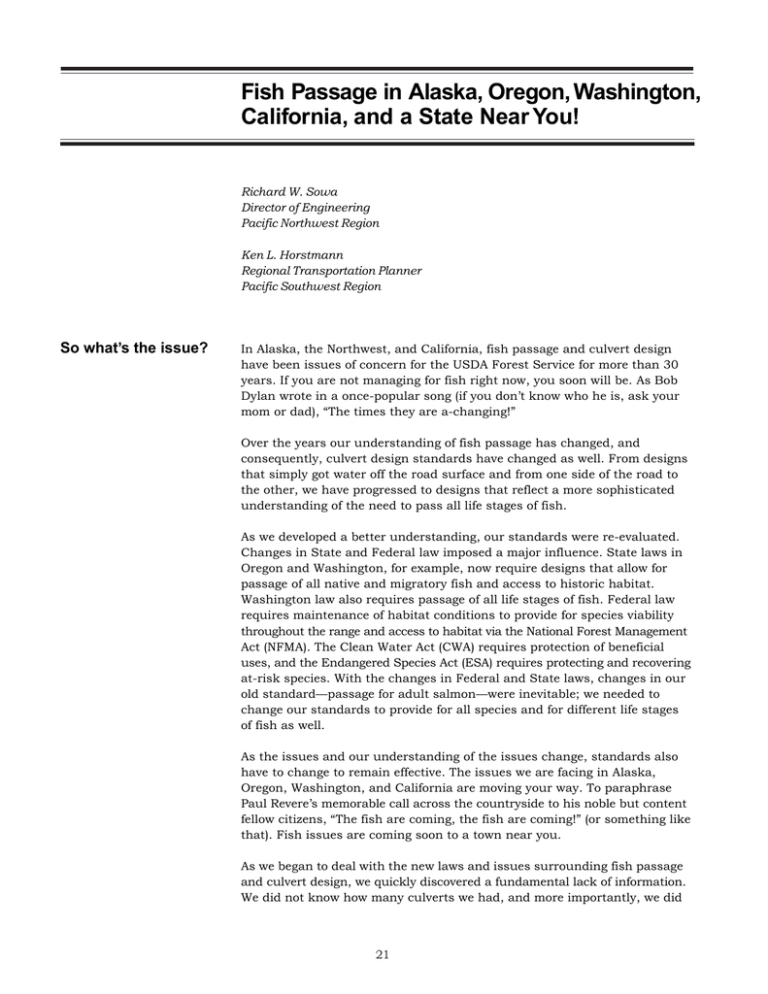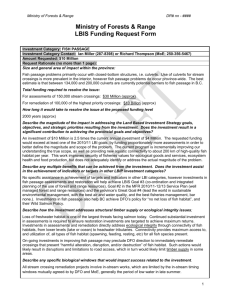Fish Passage in Alaska, Oregon, Washington,
advertisement

Fish Passage in Alaska, Oregon, Washington, California, and a State Near You! Richard W. Sowa Director of Engineering Pacific Northwest Region Ken L. Horstmann Regional Transportation Planner Pacific Southwest Region So what’s the issue? In Alaska, the Northwest, and California, fish passage and culvert design have been issues of concern for the USDA Forest Service for more than 30 years. If you are not managing for fish right now, you soon will be. As Bob Dylan wrote in a once-popular song (if you don’t know who he is, ask your mom or dad), “The times they are a-changing!” Over the years our understanding of fish passage has changed, and consequently, culvert design standards have changed as well. From designs that simply got water off the road surface and from one side of the road to the other, we have progressed to designs that reflect a more sophisticated understanding of the need to pass all life stages of fish. As we developed a better understanding, our standards were re-evaluated. Changes in State and Federal law imposed a major influence. State laws in Oregon and Washington, for example, now require designs that allow for passage of all native and migratory fish and access to historic habitat. Washington law also requires passage of all life stages of fish. Federal law requires maintenance of habitat conditions to provide for species viability throughout the range and access to habitat via the National Forest Management Act (NFMA). The Clean Water Act (CWA) requires protection of beneficial uses, and the Endangered Species Act (ESA) requires protecting and recovering at-risk species. With the changes in Federal and State laws, changes in our old standard—passage for adult salmon—were inevitable; we needed to change our standards to provide for all species and for different life stages of fish as well. As the issues and our understanding of the issues change, standards also have to change to remain effective. The issues we are facing in Alaska, Oregon, Washington, and California are moving your way. To paraphrase Paul Revere’s memorable call across the countryside to his noble but content fellow citizens, “The fish are coming, the fish are coming!” (or something like that). Fish issues are coming soon to a town near you. As we began to deal with the new laws and issues surrounding fish passage and culvert design, we quickly discovered a fundamental lack of information. We did not know how many culverts we had, and more importantly, we did 21 not know what life stages could successfully pass through our culverts. We also did not have an agreed-upon method for evaluating passage capacity. We did know which culverts blocked adult salmon, but we did not have a comprehensive database to store that information, which is disconcerting if you consider yourself a leader in natural resource management. What Are The First Steps? To save a lot of time and energy, we recommend that you start on this issue now before it runs over you. We want to share our trial by fire, as well as the reasonable logical process we developed to catch up to the issue. First, we established a protocol, using an interdisciplinary (no, that isn’t a bad word) process. To avoid reinventing the wheel, we looked around and discovered that Region 10 already had a protocol in place. We had fish biologists, hydrologists, and engineers review and modify that protocol to fit our region’s needs. Because each member of the interdisciplinary team had some critical input into the process, it is a better protocol. A critical component was to make the protocol apply to more than Federal land exclusively. We coordinated with the Oregon and Washington departments of fish and wildlife. While not identical, our protocols enable us to share culvert information across jurisdictional lines successfully. We also had to ensure that ultimately we could determine culvert replacement priorities on a statewide scale. It would be illogical to remove barriers at the headwaters if the problem was in an estuary. (To request a copy of the protocol, contact Dave Heller, Region 6 regional fisheries program manager, 503-808-2994; Jeff Uebel, fish habitat program manager, 503-808-2847; or Paul Anderson, acting Columbia River Basin fisheries coordinator, 503-808-2930.) Second, we conducted the inventory. Here are two of a number of ways to conduct such an inventory: In Region 6 we pilot tested the protocol on three national forests. Based on what we learned from the pilot tests, we set up an interdisciplinary field team to train forest personnel to do the inventory and to oversee the data collection. We wanted to ensure consistent inventory methods regionwide so we could compare data between forests. Through our deferred maintenance program, we funded 13 forests in fiscal year (FY) 2000 to do the field inventory work, and we funded the remaining 7 forests in FY 2001. Today our database is up and running, and soon we will have the capacity to evaluate culvert replacement needs statewide. We estimate that our cost for conducting the inventory and importing the data into the database was about $155 per culvert. Region 10 has completed its inventory and Region 5 has contracted out an inventory for the four northern forests in the region. Third, we analyzed the data collected. In Region 6 over the last 2 years, we have inventoried approximately 4,200 culverts on fish-bearing streams and have done some preliminary interpretation of the data. 22 With 4,200 sites inventoried in FY 2000 and loaded into the database, we learned from the data that about 10 percent of fish passage culverts pass all life stages, 8 percent need further study, and 82 percent do not pass all life stages of fish as required by State and Federal law. The inventory shows that habitat reduction is greatest for juveniles and resident fish and least for adult salmon. The effects of habitat reduction include population fragmentation, loss of spawning and rearing habitat, and loss of seasonal refuge habitat. Much of the habitat loss is in the upper reaches of stream systems. Washington and Oregon State inventory results are similar to those found on national forests, with up to 80 percent of their pipes failing to pass some life stage of fish species. What do we do now? Recognize the size of the problem. National forest lands in Region 6 contain an estimated 6,000 problem culverts—State and county roads could have as many as 8,000 more. At an estimated cost of $125,000 per pipe for fulfilling National Environmental Policy Act (NEPA) provisions, and preconstruction and contract administration costs, it could cost the USDA Forest Service $750 million to provide passage for all life stages of fish. Although changing protocols will substantially increase cost, that is not necessarily bad news, especially if the change is in a positive direction. Knowledge of this expensive estimated cost compels us to set and maintain priorities. Because we understand the issues better now, we know that we need to do things differently. We hope that the sharing of our experiences will help other regions see the dark clouds (that look a lot like fish) on the horizon and start to do their own culvert inventories. We are willing to share the specifics of what we have learned. The most significant awareness for us is that we have to manage this issue on a statewide scale. For the first time in our history, we have the tools to deal cross-jurisdictionally to solve critical natural resource issues. Tools such as PL 106-393 (payments to counties), the Oregon Watershed Enhancement Board (OWEB), Salmon Recovery Fish Board (SRFB), and other State salmon initiatives, in conjunction with authorities such as the Wyden amendment, can help revamp or replace the most important pipes first, regardless of land ownership. We hope that this article will provide you with a better understanding of the fish passage issue coming to a forest near you. We are confident that it is a manageable issue, but it does take time and money to address. We urge you to spend some time planning a strategy for the fish passage issue before it becomes an urgent costly necessity. 23



